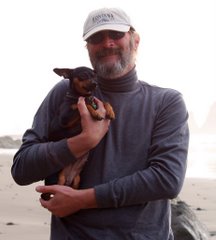I’d like to say a word for the cowboy.
The road he treads is difficult and stony.
He rides fer days on end with jist a pony fer a friend.
I sure am feelin’ sorry fer the pony.
--Oscar Hammerstein II
Beaverhead County is Montana’s largest in area and last Saturday, September 6th, we drove most of it. Well, not really, but when you’re driving over Forest Service Roads at five to ten miles per hour for four hours it sure feels like you’re never gonna get home again. Between the rocks and the ruts, the truck bounced and jittered, and the camper swung back and forth so violently, that I feared the truck bed would separate from the cab or the weight of the camper would have us on our side.
Admittedly, my DeLorme Montana Atlas bears a 1994 copyright, but do roads just disappear? Our friend Stan had the same atlas, but with a 2001 copyright, and his showed the same roads. Both books claimed we were on Forest Service Road 945.1, but all the signs said 944. And try as we might we could not find the connecting road that would get us to what my atlas named Road 12. Stan’s atlas called it Road 945.2. Maybe that should have told us something.
Our friends Stan and Leon live on top of a ridge near Stevensville, Montana. Whenever they can, they like to put their canoe on top the Jeep and head out for some fishing and canoeing. I had mentioned that if they ever wanted company, they should let us know. Thursday, September 4th, Leon sent me an e-mail saying that they were planning on spending the upcoming weekend at Twin Lakes in the Big Hole Valley. While I’ve spent lots of time in the Big Hole, I’d never been to Twin Lakes.
Kevin had, as he grew up in Beaverhead County, and when I started looking online for geocaches around the town of Wisdom, Kevin informed me that we wouldn’t be going anywhere near Wisdom. Now as I looked at the map, the only alternative to driving through Wisdom was to take a Forest Service road that followed the base of the mountains. Still I bowed to his experience and said “Drive on!” We met Stan and Leon at the supermarket in Stevensville, and they agreed to try our route, so the four of us took off on Captain Clark’s 1806 route through the Bitterroot and Big Hole Valleys.
On their return from the Pacific in 1806, Lewis and Clark’s Corp of Discovery camped at Traveler’s Rest, now a Montana State Park just a few miles south of Missoula. On July 3rd, the company split with Lewis heading north and Clark south. Lewis and his men spent July 4th on the site of what is now Missoula and sure enough, there is a plaque right downtown saying “Lewis slept here.” Well, maybe not in so many words, but that’s the jist of the message—and right in front of a motel, too.
Clark took his men and headed south, traveling up the Bitterroot River and crossing the Continental Divide at Gibbon’s Pass. You can read about the whole Lewis and Clark adventure here. And while we’re on the subject of Lewis and Clark, all Montana school children learn that the Corps of Discovery followed the Missouri River upstream to the point where three rivers come together—the site of present day Three Forks, Montana. We learn that the three rivers are named the Madison, the Jefferson and the Gallatin—named for the Secretary of State (and fourth US President) James Madison, President Thomas Jefferson, and Secretary of the Treasury Albert Gallatin. Wikipedia will even tell you that Lewis himself named the rivers on the way west in 1805. What isn’t so well known is that while traveling up the Jefferson, they came to another confluence of rivers which they named Philanthropy, Philosophy and Wisdom. Today we know these rivers as the Ruby, the Beaverhead, and the Big Hole. The Big Hole flows right past the town of Wisdom—the only place name where Lewis’s appellation still exists. (I hesitate to suggest that there is no philanthropy or philosophy in Montana.)
The Big Hole is also the site of one of the great tragedies of US history. In 1877, a band of Nez Perce Indians, led by Chief Joseph, fled their homeland in northeastern Oregon heading east. The US Government was determined to place all native peoples on reservations, and this group of Nez Perce resisted. They crossed the Idaho panhandle and entered Montana Territory at Lolo Pass. Like Clark, they traveled up the Bitterroot and crossed the Continental Divide into the Big Hole Valley. Believing themselves safe, they camped for several days in early August, only to be awakened by gunfire. The cavalry had arrived. Roughly one-tenth of the encamped Nez Perce were killed—men, women and children, but the survivors were able to force the US military to retreat. After the battle was over, the Nez Perce continued east, through Yellowstone Park then north across central Montana until they were finally stopped at the Battle of the Bear Paw, near present day Chinook Montana. The Nez Perce had traveled 1100 miles, fighting US forces the entire way. When captured at the Bears Paw, they were less than 40 miles from the Canadian border. Chief Joseph’s speech of surrender remains today one of the great pieces of American literature. It bears repeating in its entirety.
________________________________________
Surrender Speech In the Bear Paw Mountains
- October 5th, 1877
________________________________________
I am tired of fighting.
Our chiefs are killed.
Looking Glass is dead.
Toohulhulsote is dead.
The old men are all dead.
It is the young men who say no and yes.
He who led the young men is dead.
It is cold and we have no blankets.
The little children are freezing to death.
My people, some of them,
Have run away to the hills
And have no blankets, no food.
No one knows where they are-
Perhaps they are freezing to death.
I want to have time to look for my children
And see how many of them I can find.
Maybe I shall find them among the dead.
Hear me, my chiefs, I am tired.
My heart is sad and sick.
From where the sun now stands
I will fight no more forever...
Hinmahtoo Yahlatkekeht of the Nez Perce
("Thunder Rolling in the Mountains." or "Chief Joseph")
I cannot visit the Big Hole Battlefield without choking up. Even today, as I write of these events, I feel my throat closing and my eyes filling. The only other places I’ve visited that have the same effect are Culloden Moor in Scotland, and the Gallipoli battlefields in Turkey. Even as a child, the Big Hole spooked me in a way that Montana’s other “famous” battlefield, The Little Big Horn, did not. As the bumper stickers say, “Custer had it coming.”
This weekend we were not stopping at the monument. We had driven up the Bitterroot on US 93, and turned east crossing the Continental Divide at Chief Joseph Pass. We drove into the Big Hole on Montana 43, turning off the highway just east of the monument.
The dirt road ran in a southwesterly direction across the hayfields of the Big Hole Valley, known locally as the home of 10,000 hay stacks. Relatively smooth, as dirt roads go, our route was taking us toward Forest Service Land and the Continental Divide and Idaho. It was also supposed to take us to another Forest Service road that would connect up with the road to Twin Lakes. Or so both DeLorme and Kevin assured me.
Passing numerous groups of hunters out for the opening weekend of archery season, we followed a game warden right up to the point where he headed west toward Idaho and we turned south toward Twin Lakes. I wasn’t watching the odometer, but Leon tells me we’d traveled twenty miles from the highway when we finally gave up and turned around. Oh we didn’t want to give up, but our road had become two tracks, branches were breaking off as they scraped the camper, and there was a log down across the “road.” Somehow Kevin managed to get the F250 turned around without having forty acres, and we started back toward the highway.
Still believing our maps, we explored a couple of roads that forked off road 944, but in the first case, we came to a fence and a no trespassing sign, and in the second we found ourselves at an impassable irrigation ditch. Giving up, we returned past all the hunters and turned east on Montana 43. We were going to go through Wisdom after all.
The road to Twin Lakes was in better shape than Forest Service 944, but it was still a dirt road, and it was still slow going. This time, sixteen miles after turning off the pavement, we found ourselves at a beautifully maintained campground on the shore of the lower of the two lakes. We built a campfire and Stan and Leon set up their tent. As we were carrying our house on our back, or rather the truck’s back, Kevin and I just sat back and watched.
Twin Lakes sits below the mountains of the Continental Divide on the Montana side of the Montana/Idaho state line. At 7200 feet, the campground was higher than our last excursion—Pat’s Knob, but the weather was crisp and clear. The lakes looked inviting, but we decided that we’d wait until after dinner to get out on the water. Unfortunately, by the time we finished eating and cleaning up the campsite, it was too late to canoe.
I won’t speak for anyone else, but I slept well Saturday night, and when I awoke Sunday morning, Stan and Leon had a fire blazing and were off hiking along the lake. The water was glass smooth, and reflected the mountain scenery to perfection. As you look at the scenes in my Picasa gallery, you’ll assume that some of the photos are upside down. Nope, it just that I aimed at the water and not the sky.
As we ate breakfast, clouds started moving in and the temperature dropped. Remembering how cold we had been on Monday, neither Kevin nor I were keen on getting out into the middle of the lake in a rain storm. As it turned out, Stan and Leon were just as happy to leave their canoe on top the jeep, so none of had a chance to glide cross that beautifully clear water. We all agreed that Twin Lakes was worth another trip—this time without exploring the National Forest’s back roads.
On the way out, Kevin stopped frequently so that I could document the scenery. We had lunch at Fetty’s Café, in business since the 1930s, and this time I can really recommend a place. Kevin’s burger was moist and my salad and chili were fresh and tasty. The waiter was cute and with tip, our lunch came to $25.00. I’ll go back to Fetty’s.
And by the way, I found two of the three geocaches I was seeking in the Wisdom area. Can’t wait to get back over there.









1 comment:
According to the world of Roy & Dale:
"Some trails are happy ones,
Others are blue.
It's the way you ride the trail that counts,
Here's a happy one for you."
Oh, say can you whistle? Try this one:
http://www.youtube.com/watch?v=gvZFESrKvCE
Post a Comment